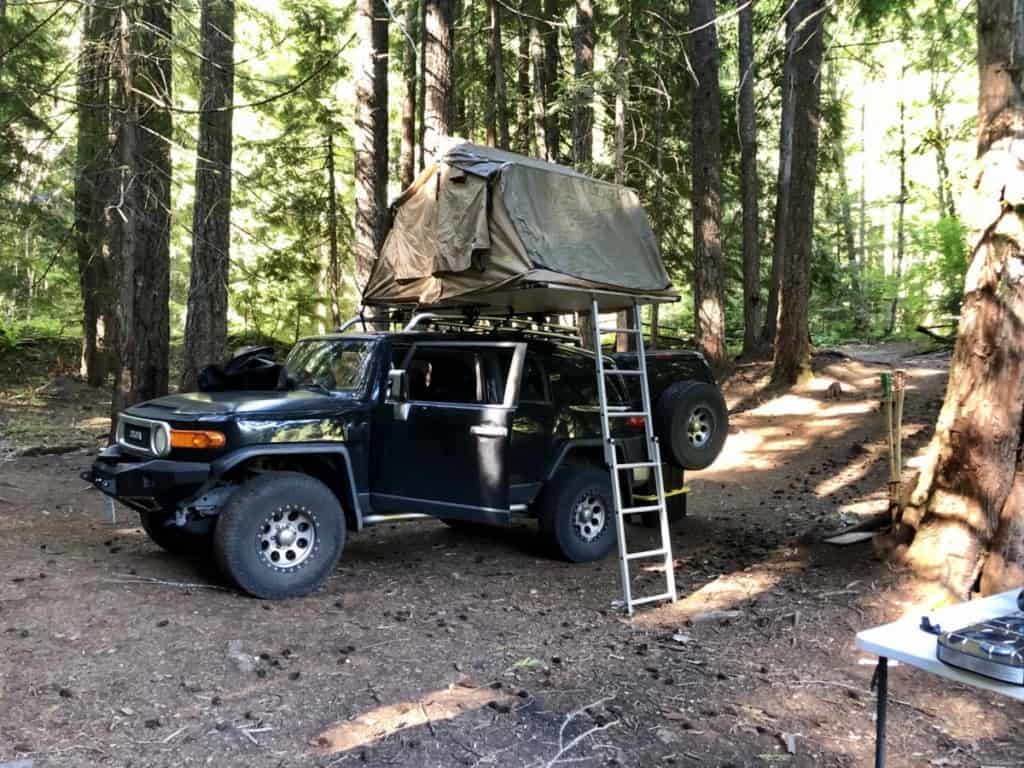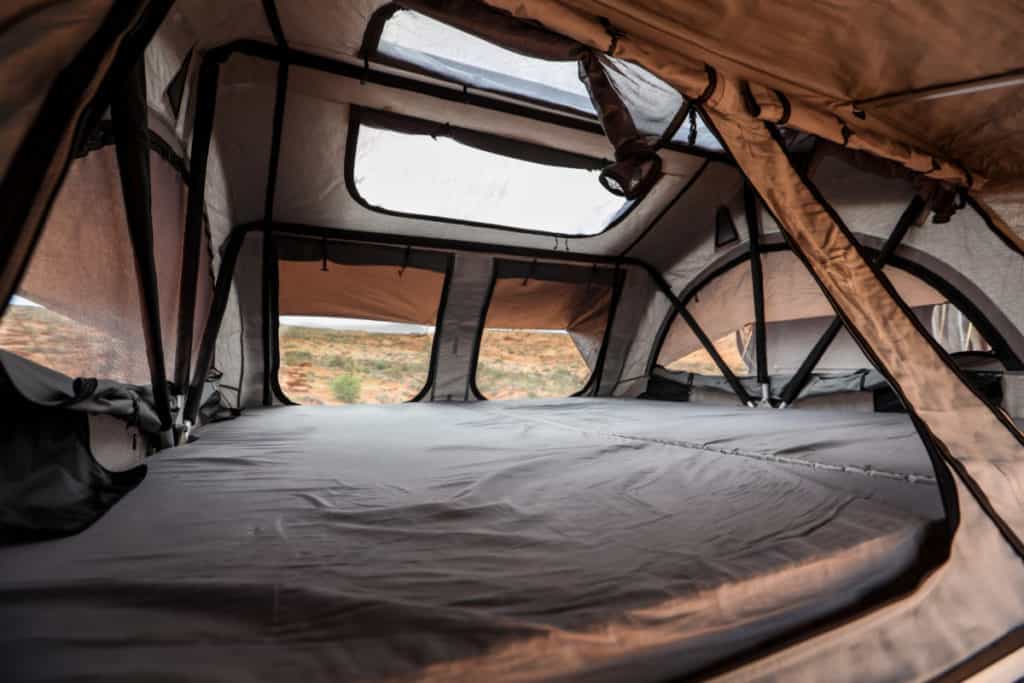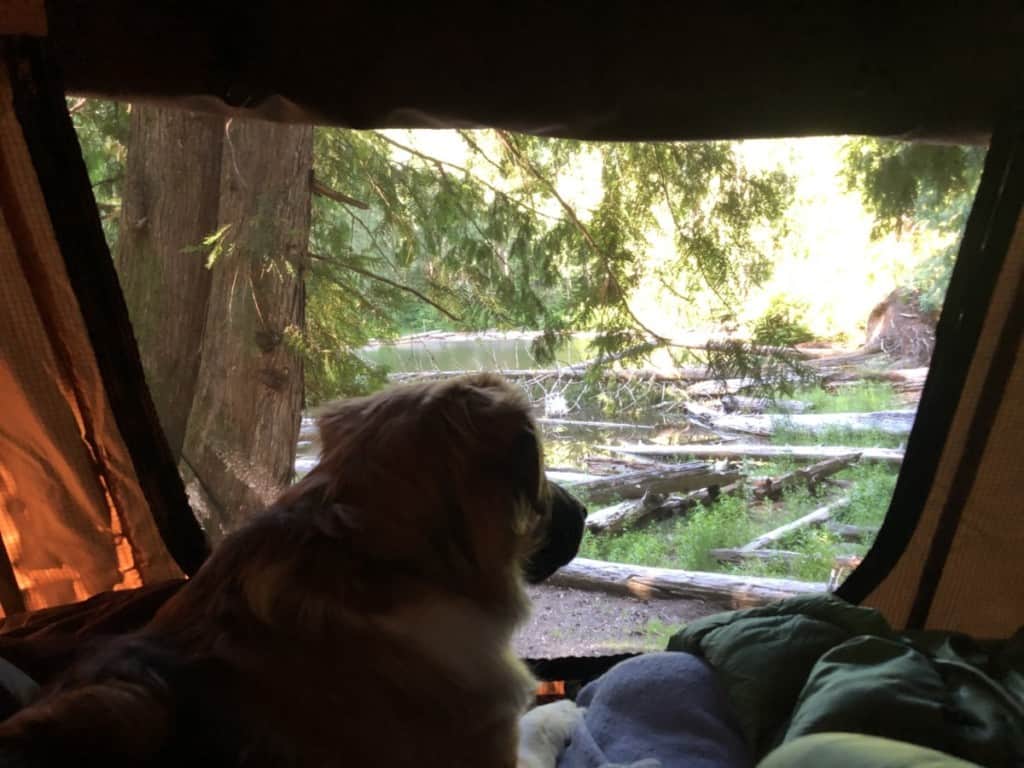
When looking to buy or just curiously searching about roof top tents, you may wonder what are the major advantages they have over ground tents or car camping.
The advantages of a roof top tent are its ability to stay clean, dry, provide luxury, comfort, and stay off of the ground in a convenient and easy fashion.
These a just a few of the prominent advantages roof top tents (RTTs) offer to campers. There are many more to point out, some being obvious and some not so obvious to a beginner.
So let’s talk a bit more about the advantages I have noticed in my experiences camping with a RTT! Towards the end of the article, I will talk about the disadvantages I have come to find while owning one as well.
Roof top tent advantages:
Cleanliness
For those that have camped in a ground tent, you know just how quickly the tent will get dirty. It gets covered in dirt the second you lay it down and once you walk inside the tent a couple of times you track in the dirt too. An even worse scenario is when it rains and the ground becomes muddy.
With a RTT you don’t have to worry about these issues since it doesn’t sit on the ground. When you enter the tent, you can place your shoes inside a waterproof shoe bag that sits just outside the entrance of your RTT. Taking your shoes on and off before getting in the tent is so much easier than doing it using a ground tent.
Camping on the beach is fun in theory, but the amount of sand that gets into your tent and gear is the worst part. Sand always seems to find a way to get into the tent but it will be far less when using a RTT.
Also, you won’t need to rinse off or clean the RTT after a muddy camping trip like you would for a ground tent. It is still a good idea to clean your RTT periodically and you can learn how to properly do this here from my Step By Step Cleaning Guide.
Comfort
The comfort in a RTT is second to none. The biggest difference-maker for me is simply having a flat surface to sleep on. When in a ground tent, even with a nice mattress pad, the bumpy and uneven surface makes it very uncomfortable.

This is especially true if you go on an extended camping trip for a few days at a time. The built-in mattress that RTTs have will usually be about 2-3.5 inches thick and are made of high-density foam. The mattress is plenty comfortable.
To have the most comfortable sleeping arrangement, owners will even add another mattress topper. For more details on other ways to Make A RTT More Comfortable, click the link provided for some helpful tips and examples!
While on the topic of comfort, let’s talk about bedding. Being able to skip the process of blowing up an air mattress and making the bed is a huge time saver.
Most RTTs, especially hardshells, allow you to keep your bedding stored inside the tent when closed. This means pillows, sheets, and blankets can all be kept ready to use inside the tent without having to take them out after every use.
Besides the fact that this will save you huge amounts of time, I just like knowing the fact that I won’t forget anything as I rush out of the house for my next camping trip!
Effortless setup
This may be a debatable topic for some but I feel that RTTs are easier to setup. For one, I stay much cleaner since the tent never touches the ground.
But also, I don’t have to use those stupid poles, tie-downs, or stakes to secure the tent. Setting up a ground tent can vary a lot, but counting the time to do that as well as make the bed probably takes 15-20 minutes all together.
Some RTTs are faster to deploy than others. For example, foldout softshell RTTs require you to take off the PVC cover and undo multiple straps before use. Depending on the model, the set up should take roughly five minutes. I would argue closing the tent takes a few more minutes to tuck all of the fabric in as you close it too.
However, many hardshell RTTs only require a couple of clamps to be undone and then the gas struts will pop open the tent for you. This process takes only 60 seconds to do with little to no effort required!
I understand there are some pop-up ground tents that can be put up in minutes, but excluding the outliers, RTTs in my opinion do have the advantage here!
Packing less gear
As you head out for a camping trip and pack your vehicle with all of the necessities, you quickly realize how little space you have left for everything you need.
This is an area where the RTT shines since it sits on top of your vehicle. You also don’t need to worry about the space the air mattress would normally take up as well. And as I mentioned when talking about comfort, most if not all of the bedding can be stored inside the RTT when it’s closed too!
I can see this being very valuable for a large family where space is very limited in the car. It’s also nice for forgetful people, like myself, who always seems to forget an item or two for my trip! Having the tent ready to go at all times gives you peace of mind and one less thing to worry about.
Luxury
There is definitely a level of luxury that comes with a RTT. Making it a happy medium or step above a ground tent, but less luxurious than a teardrop trailer. RTTs are pricey, but not when comparing it to any trailer!
Some RTTs can cost over $4,000 dollars and will be made of aluminum and steel. Other luxuries include built-in fans, solar panels, LED lighting, automatic open and closing, an annex, awning, and many other features.
You can make your RTT fully electric with solar panels mounted directly to your tent. Some RTTs even have USB and 12V plugins inside the tent that are ready to be hooked up to a power source.
I could go on forever about the possible upgrades you can make to a RTT. There is nothing like it in the ground tent category, which is why I consider RTTs far more luxurious for campers.
All-season use
The best way to extend your camping season to later in the year or year-round is by having a well-equipped tent and the proper equipment. There are plenty of all-season RTTs which are fitted with extremely thick fabric, anti-condensation mats, insulated floors, and even more addons.
A natural advantage they have is being elevated in the air which will allow you to stay dry but also not sleep on the freezing cold ground.
Softshell and hardshell tents alike can handle four-season use, but I would give the edge to hardshells. If it happens to rain or snow, I’de rather be in a hardtop RTT that will keep me dry and handle the weight of accumulated rain or water.
Fun factor
This is somewhat of an intangible but in my eyes, it is an advantage! Owning a RTT is just FUN! I really do love being 8 feet off the ground and having the best possible view as I relax in my tent.
Friends and family will immediately tell you how cool it is once they actually understand how it works! At first, people didn’t even know how it worked. After posting plenty of pictures on camping trips, people love it and have flooded me with questions.
It has been an awesome piece of equipment to own and I have found myself camping more frequently since I bought it. With all of the great advantages that come with a RTT, it’s still not all sunshine and rainbows. Here are some clear disadvantages that come with owning one.
RTT Disadvantages
Before diving into the downsides of a RTT, I have handpicked this article for you, Roof Top Tents VS Ground Tents. It highlights some of the pros and cons of using each tent. It is a quick read and talks a bit more about the major differences that I have found using each setup!
If you bring your dog camping, like many of us do, it can be a very difficult task to get them inside the tent. For smaller dogs, I wouldn’t even sweat it. But I own a 60-pound dog and it is a process to get him in every time.

If you’re a bit older or simply can lift your dog because they are so heavy, this is something you need to think about. There are workarounds to this though. If you search “dog” using the search bar in the top right corner of my website, it will direct you to my article where I give many examples to fix this.
That said, it’s no walk in the park compared to simply opening the tent door for them.
Another disadvantage is storing the RTT. Due to a lack of storage space or the inability to move the 100 to 200-pound tent, many RTT owners just leave the tent on their vehicle year-round.
This is fine but it will add wear and tear to your vehicle as well as reduce your car fuel efficiency.
These are just a few disadvantages that have really stood out and mattered to me as an owner. I would highly recommend reading the article where I compare them to ground tents because I give many more examples where a RTT is at a clear disadvantage.
Wrapping Up
With all purchases in life, there is some give and take. Even though the RTT brings so many awesome and fun features to the table, it too has its drawbacks.
Overall, I think WAY more people are very happy with purchasing a RTT compared to those who aren’t. The ones that don’t seem content with them are also the people that get the least amount of use out of them.
Whether you end up buying one or not doesn’t matter to me, but I do want to be as helpful as possible. I recommend you check out our Youtube channel and skim through the Buyers Guide section of our blog. Both of these resources will be super helpful if you’re considering buying a RTT!
